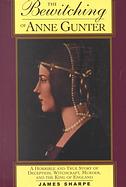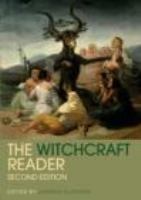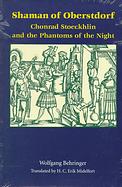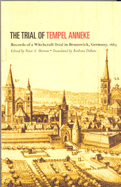Course Objectives:
This course has several objectives, some of them substantive, others related to research and writing skills. Obviously, students will learn a great deal about witches and beliefs about them—who they were, or who they were imagined to be, what people imagined their capabilities to be, and so on. Along the way, students will also learn a great deal about the internal logic of premodern criminal justice systems; about the structure of state power in premodern Europe; about hierarchies of power, status, and gender; and about the basic tenets of Christianity in its Catholic and Protestant manifestations.
More importantly, this course is an exercise in historical imagination: in order to understand the phenomenon of late medieval and early modern beliefs surrounding witchcraft, students must learn to suspend basic assumptions about how the world works and to enter, through the informed imagination, a world governed by assumptions and logics that often bear little resemblance to our own.
As for practical skills, students in this course will acquire or refine their ability:
- To identify primary sources that are relevant to a particular research purpose;
- To analyze those sources critically from a position that is both theoretically informed and free of anachronism;
- To identify secondary literature that is pertinent to a particular topic and to read that literature critically;
- To identify the web-based resources that are relevant to a particular topic, and to distinguish between properly vetted and unvetted web-based resources;
- To build a historical argument around the primary sources; and
- To present ideas and debate them constructively.
Requirements:
This course operates as a seminar, which as a practical matter
means that our meetings will be divided between lectures and discussions. A typical
week might begin with a lecture that surveys a particular topic, followed by discussions
of primary and secondary readings. But as the course outline shows, there will
also be plenty of variation on this general plan. In any event, everyone should
plan on reading the equivalent of a book each week during the term, and because
the emphasis on discussion is so heavy, it is incumbent on everyone to attend
class prepared to share ideas and debate them. Needless to say, it is imperative
that you attend each session.
There will be one examination, a midterm in
week 5.
As for written work, there are two categories. First, there are three "Document Analysis" exercises, due on Friday at 5:00 pm in each of the first three weeks of term. Document analysis exercises are designed to sharpen your skills in reading primary sources critically, in order to extract historical meaning from them. Together, the make up 15% of your total evaluation for the course (see below).
The second category of written work consists
of a term paper prospectus and the term paper itself, which must be at least 3000 words in length (excluding bibliography). During the term, I will offer a list
of suggested topics from which you are welcome to choose; should you wish to
study a different topic, however, you are welcome to discuss it with me and
pick an alternate.
Whatever your topic, I will ask you to submit a prospectus for your
term paper, which will be due in the second session of week 6.
A prospectus should
contain five things:
1) A paper title;
2) A description of your topic, one or two paragraphs in length;
3) A description of how you intend to investigate your topic, including a list
of books, articles, or primary sources that you intend to use in the process;
and
4) Your ideas about why the topic is historically significant.
5) A bibliography
The most important thing is that you
immerse yourself in a topic that engages your imagination and that you research
it thoroughly. My one requirement is that for your term paper you must
use at least two texts (primary or secondary) that are not included among the
course readings; I also want you to identify these texts in the prospectus.
Naturally, you are welcome and encouraged to make full use of the course readings
in addition.
Since historians can’t agree on much
about causes and historical meaning of witchcraft and witch persecution, it
should be obvious that a great deal in this set of topics is subject to interpretation.
Your term paper will be an interpretation, too. That means, of course, that
you will have to articulate a thesis statement and try to prove your point with
logic, argument, and the critical analysis of evidence. In a well-written term
paper, every paragraph will be written with the goal in mind of weighing evidence
in support of an argument that you consider historically true. Your paper will
be evaluated according to how well it does these things.
Evaluation:
The overall breakdown of evaluation
is this:
Reading, Attendance, & Participation: 20%
Document Analyses: 15%
Prospectus: 10%
Mid-Term Exam: 20%
Term Paper: 35%
For a few pointers both on how to put together an "A" paper and what distinguishes
it from average or unsatisfactory work, click here.
Generally speaking, an "A" paper is one that has a clear and meaningful thesis;
an "A" paper is researched thoroughly and makes use of all information on the
topic available in primary sources, book-length monographs, and scholarly journal
articles; an "A" paper is documented fully and completely with footnotes or
endnotes and bibliography; an "A" paper is one that engages evidence and marshals
it critically and persuasively in support of the thesis; and finally an "A"
paper is one that is at once well-written and free of grammatical and typographical
errors.
If you have a documented disability and anticipate needing accommodations in
this course, please make arrangements with me soon. Also, please ask the Counselor
for Students with Disabilities to send me a letter verifying your disability
at the following address:
David M. Luebke
1288 Department of History
University of Oregon
Eugene OR 97403-1288
Academic Honesty:
A note on academic honesty, plagiarism, repurposing, fabrication, and
cheating: All work submitted in this course must be your own and produced exclusively
for this course. The use of sources (ideas, quotations, and paraphrases)
must be properly acknowledged and documented. Note that this requirement covers
more than just direct quotes: any idea or analysis you borrow from another person
must also be acknowledged, too! Just remember that it’s OK to borrow ideas—as
long as you give credit where credit is due.
The policy for this course is simple. Anyone who cheats on an exam or who turns
in work for credit that is repurposed or plagiarized or that is not substantially his/her own will receive
an “F” for the assignment, and because each assignment is a minimum requirement for the entire course, a failing grade on the written assignment will result in a failing grade for the entire course. Students suspected of plagiarism or cheating will
also be reported to the Office of Student Conduct and Community Standards, the university agency responsible for adjudicating cases of academic
dishonesty. The ultimate penalty for plagiarism is expulsion from the university. If you have any doubt about the meaning of academic dishonesty,
please refer to the university's standard
definitions. You can also find useful information on avoiding academic
dishonesty at the University
Library. Finally, all written work must be submitted
on time; late work will be accepted only with documented medical justification.
As a safeguard against academic dishonesty, all written work must be submitted in two forms: (i) a paper print-out, in order to make facilitate grading; and (ii) electronically, by depositing your work in VeriCite on Canvas.
If you are in any doubt about the what constitutes of academic dishonesty, consult the definitions employed in the Student Code of Conduct (OAR571-021-0100). For the consequences of academic dishonesty, refer to the sanctions enumerated in the Student Code of Conduct. Violations will be taken seriously and are noted
on student disciplinary records. In severe cases, violations of the Student Code of Conduct may result in the student's suspension or the revocation of her/his degree.



